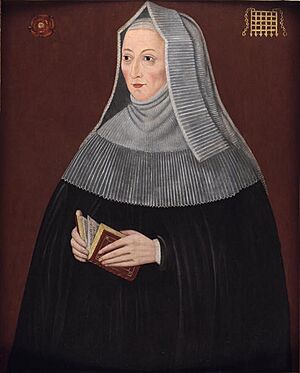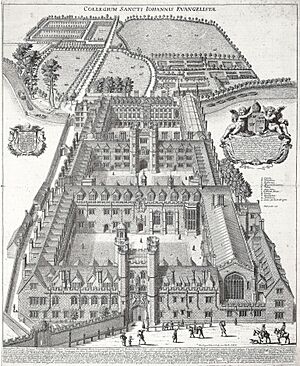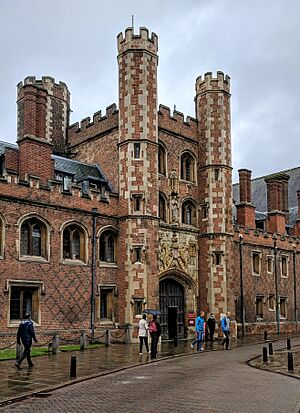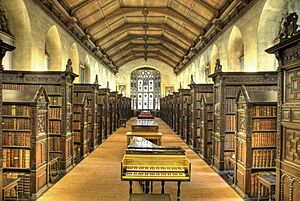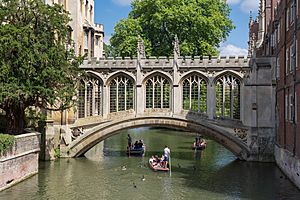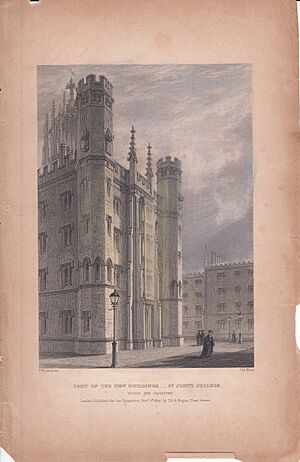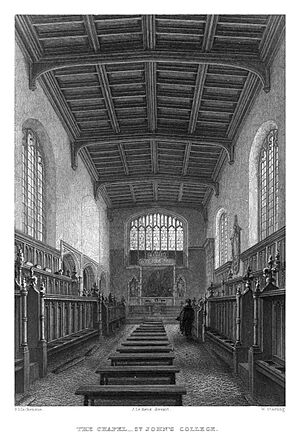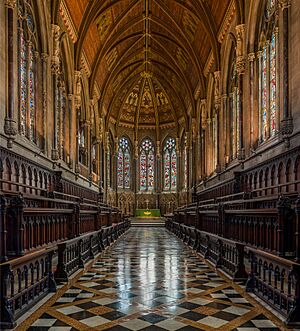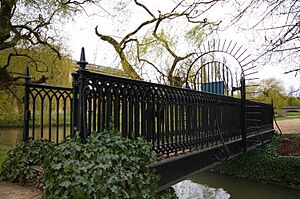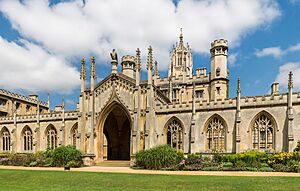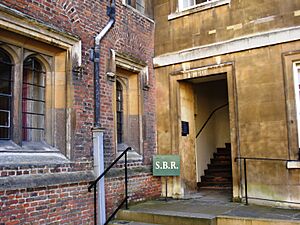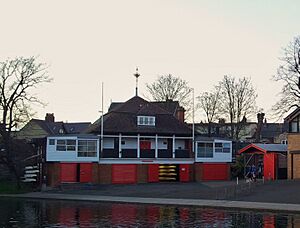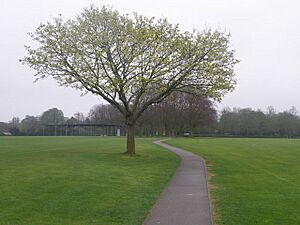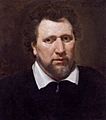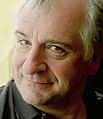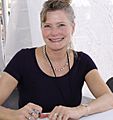St John's College, Cambridge facts for kids
Quick facts for kids St John's College |
||||||||||||||||
|---|---|---|---|---|---|---|---|---|---|---|---|---|---|---|---|---|
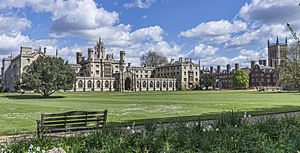
View over the rear buildings from the Backs
|
||||||||||||||||
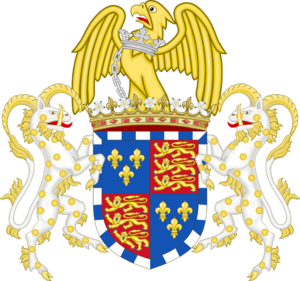
Arms of St John's College, being the arms of the foundress Lady Margaret Beaufort
Blazon: Royal arms of England a bordure componée azure and argent |
||||||||||||||||
|
|
||||||||||||||||
| University | University of Cambridge | |||||||||||||||
| Location | St John's Street (map) | |||||||||||||||
| Full name | The College of St John the Evangelist in the University of Cambridge | |||||||||||||||
| Abbreviation | JN | |||||||||||||||
| Motto | Souvent me Souvient (Old French; motto of the foundress Lady Margaret Beaufort) | |||||||||||||||
| Motto in English | I often remember / Remember me often | |||||||||||||||
| Founder | Lady Margaret Beaufort | |||||||||||||||
| Established | 1511 | |||||||||||||||
| Named after | The Hospital of St John the Evangelist | |||||||||||||||
| Sister colleges | ||||||||||||||||
| Master | Heather Hancock, from October 2020 | |||||||||||||||
| Undergraduates | 634 (2022–23) | |||||||||||||||
| Postgraduates | 368 (2022–23) | |||||||||||||||
| Map | ||||||||||||||||
| Lua error in Module:Location_map at line 420: attempt to index field 'wikibase' (a nil value). | ||||||||||||||||
St John's College is one of the colleges that make up the University of Cambridge. It was started by Lady Margaret Beaufort, who was the mother of King Henry VII of England. The college officially began on April 9, 1511. Its main goals are to help with education, learning, and research.
St John's is one of the biggest colleges in Oxbridge (Oxford and Cambridge) when it comes to the number of students. In 2022, it was ranked 6th out of 29 colleges in the Tompkins Table, which is a ranking of Cambridge colleges. More than 35% of its students achieved top honors. It is also the second wealthiest college in Oxford and Cambridge, right after its neighbor, Trinity College, Cambridge.
Many famous people have been part of St John's College. These include twelve Nobel Prize winners, seven prime ministers, and many important leaders. The famous poet William Wordsworth studied here, as did William Wilberforce and Thomas Clarkson, who were key figures in ending slavery in the British Empire. Even Prince William was connected to the college for a course in 2014.
St John's is well known for its amazing choir. Its students also do very well in sports competitions between colleges. The college hosts a big annual party called the May Ball. The tradition of the Oxford and Cambridge Boat Race actually started with a student from St John's. The college's boat club, Lady Margaret Boat Club, is the oldest one at the university. In 2011, the college celebrated its 500th birthday, and Queen Elizabeth II even visited for the event.
Contents
College History
The land where St John's College now stands was first home to the Hospital of St John the Evangelist. This hospital was likely founded around the year 1200. By the early 1500s, the hospital was old and didn't have much money.
Lady Margaret Beaufort, who had already started Christ's College, wanted to create another new college. Her chaplain, John Fisher, suggested using the hospital site. Lady Margaret passed away before putting the college in her will. So, it was mostly John Fisher's hard work that made sure the college was founded. He had to get permission from King Henry VIII of England, the Pope, and the Bishop of Ely to turn the old hospital into a college.
The college received its official charter on April 9, 1511. It took more time to get money from Lady Margaret's estate. Finally, in November 1512, the college could use her funds. Most of the old hospital buildings were too damaged to fix. However, the chapel was repaired and became part of the new college. A kitchen, a dining hall, and a grand gate tower were also built.
Over the next 500 years, the college grew westwards towards the River Cam. Today, it has twelve courts, which is more than any other college in Oxford or Cambridge.
St John's College first welcomed women in October 1981. The first female students arrived a year later.
College Buildings and Grounds
Great Gate
The Great Gate of St John's is the main entrance. It has battlements and is decorated with the arms of the founder, Lady Margaret Beaufort. Above these are her special symbols: the Red Rose of Lancaster and a Portcullis (a strong gate). On either side are mythical creatures called yales. Above them is a small shrine with a statue of St John the Evangelist.
First Court
First Court is the first courtyard you enter through the Great Gate. It was built between 1511 and 1520 from the old hospital buildings. The front part still looks much like it did in the 1500s. The south side was updated in the 1770s. The biggest change was in the 1860s when the old chapel was taken down. A much larger new chapel, designed by Sir George Gilbert Scott, was built in its place. This new chapel is the third tallest building in Cambridge. Parts of First Court were even used as a prison in 1643 during the English Civil War. In 2011, Queen Elizabeth II visited First Court to open a new pathway.
Dining Hall

The college's dining hall has a beautiful hammerbeam roof. It is painted in black and gold and decorated with the symbols of people who gave money to the college. The walls are covered with wooden panels from the 1520s. In 1564, Queen Elizabeth I famously rode into the college's Hall on horseback during a visit to Cambridge!
Second Court
Second Court was built between 1598 and 1602. It is often called 'the finest Tudor court in England'. The plans for this court are the oldest surviving drawings for any college building in Oxford or Cambridge. The court was paid for by the Countess of Shrewsbury. Her arms and a statue of her are above the western gatehouse. The large windows are a special feature. The Shrewsbury Tower, which is very grand, also has a statue of the Countess. Inside the north side of the court is the Long Gallery, which was once 148 feet long. Parts of the D-day landings were even planned here in the 1940s!
Old Library
The Old Library was built in 1624. Most of the money came from John Williams, who was the Bishop of Lincoln. He gave a lot of money because the college needed more space for books. The library's large window looks out over the River Cam.
Third Court
Third Court is entered through Shrewsbury Tower. This tower used to have an observatory from 1765 to 1859. The last parts of Third Court were added between 1669 and 1672. These additions included buildings with Dutch-style gables that face the River Cam.
Wren Bridge
This was the first stone bridge built at St John's College. It replaced an older wooden bridge. Although Sir Christopher Wren drew designs for the bridge, it was actually built by a local builder named Robert Grumbold. Because Grumbold's work was based on Wren's ideas, the bridge is known as the "Wren Bridge".
Bridge of Sighs
This bridge connects Third Court to New Court. It is one of the most photographed buildings in Cambridge. Queen Victoria described it as "so pretty and picturesque." It is a stone bridge with a covered walkway and decorative openings. The architect was Henry Hutchinson.
New Court
New Court was built between 1826 and 1831. It was the first major building the college built on the west side of the river. It was designed to look like a romantic 'Gothic' building. It has four floors, battlements, and tall pinnacles. Its unique look, especially from the river, has earned it the nickname "The Wedding Cake".
Chapel
The Chapel of St John's College is in the northwest corner of First Court. It was built between 1866 and 1869 to replace a smaller, older chapel. Sir George Gilbert Scott designed it, taking inspiration from a famous chapel in Paris called Sainte-Chapelle.

A generous person named Henry Hoare offered money to build the chapel, and even more if a tower was added. The tower was completed but left without bells. It is 163 feet (50 meters) high.
Inside the chapel, you can see statues of Lady Margaret Beaufort and John Fisher. There's also a painting called 'Deposition of the Cross' from around 1777. Some of the wooden carvings and stained glass are from the old chapel. The chapel also has memorials to important college members like William Wilberforce and Thomas Clarkson.
Master's Lodge and Garden
The Master's Lodge is where the head of the college lives. It's located north of Third Court and was built at the same time as the new chapel. It has a large garden. In winter, you can see the old library, the River Cam, and the Bridge of Sighs from its rooms.
Modern Buildings and Courts
After 1900, the college continued to grow. Chapel Court, North Court, and Forecourt were built in the 1930s to make space for more students. These were designed by the architect Edward Maufe.
The Cripps Building was built in the late 1960s to provide more student housing. It's behind New Court and forms two courts. This building is known for its late 20th-century architectural style.
The School of Pythagoras is the oldest building in Cambridge that is not a church. It was built around 1200, 300 years before the college! It is now used for the college's old records. Next to it is Merton Hall.
In 1987, the Fisher Building was finished. Named after Cardinal John Fisher, it has teaching rooms, conference spaces, and a student cinema.
Opposite the Great Gate is All Saints' Yard. This area includes Corfield Court, named after a main supporter, Charles Corfield. The School of Divinity, a large building from the 1870s, is also here.
College Choirs
The Choir of St John's College has a long history of singing religious music. They have sung daily services in the College Chapel since the 1670s. The choir boys go to St John's College School. The choir also travels to places like the Netherlands, the US, and Japan.
The choir has made almost 100 recordings since the 1950s. In October 2021, it was announced that girls and women would join the Choir of St John's College. This made it the first choir of an Oxford or Cambridge college to include both male and female voices for adults and children.
The adult singers in the choir also have a smaller singing group called The Gents of St John's. They sing a variety of music, from old songs to modern hits.
College Traditions and Legends
Shield and Arms
St John's College uses the same arms as Christ's College, Cambridge. These are the arms of Lady Margaret Beaufort. They show three gold fleurs-de-lis (a French symbol) and three gold lions (an English symbol), all within a blue and silver border. The college also uses Lady Margaret's crest, which is a golden eagle rising from a crown of roses and fleurs-de-lis. The college's arms are often shown with two mythical creatures called yales.
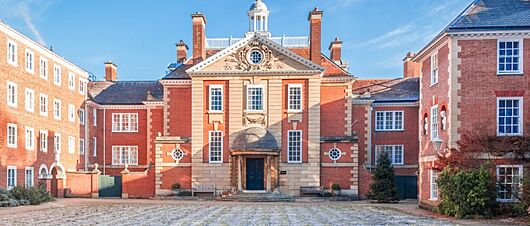
College Motto
The college motto is Souvent me Souvient, which is Old French. It was Lady Margaret Beaufort's motto. You can see it carved over gates and doorways around the college. It has a few meanings: "I often remember," "think of me often," and "I often pass beneath it" (referring to the carvings). St John's shares this motto with Christ's College, Cambridge, and Lady Margaret Hall, Oxford, as they all honor Lady Margaret Beaufort.
College Prayer
The College Prayer is said at the end of chapel services. It asks for blessings on the college and for love and learning to grow there.
College Grace
The college grace is a short prayer said before and after dinner in the hall. A student usually says the grace before dinner. The grace after dinner is said by a senior college member. These graces have been used for centuries.
| Grace | Latin | English |
|---|---|---|
| Ante Prandium (Before Dinner) |
Oculi omnium in te sperant, Domine, et tu das illis cibum in tempore, aperis manum tuam, et imples omne animal benedictione. Benedic, Domine, nos et dona tua, quae de tua largitate sumus sumpturi, et concede ut illis salubriter nutriti, tibi debitum obsequium praestare valeamus, per Jesum Christum Dominum nostrum. | The eyes of all wait upon you, O Lord: and you give them their food at the right time. You open your hand: and fill every living thing with plenty. Bless us, O Lord, and these your gifts which we are about to receive from your generosity, and grant that, being healthily nourished by them, we may be able to give you due service, through Jesus Christ our Lord. |
| Post Prandium (After Dinner) |
Infunde, quaesumus, Domine Deus, gratiam tuam in mentes nostras, ut his donis datis a Margareta Fundatrice nostra aliisque Benefactoribus ad tuam gloriam utamur; et cum omnibus qui in fide Christi decesserunt ad caelestem vitam resurgamus, per Jesum Christum Dominum nostrum. Deus pro sua infinita clementia Ecclesiae suae pacem et unitatem concedat, augustissimum Regem nostrum Carolum conservet, et pacem universo Regno et omnibus Christianis largiatur. | Pour forth, we ask, Lord God, your grace into our minds, that we may use these gifts, given by Margaret our Foundress and other Benefactors, to your glory. And with all who have died in the faith of Christ, may we rise again to life in heaven, through Jesus Christ our Lord. May God, in his infinite mercy, grant his Church peace and unity, preserve our most august king, King Charles, and grant peace to the whole Realm and to all Christians. |
Rivalry with Trinity College
St John's has a friendly rivalry with Trinity College. They often compete in sports and academics. This rivalry might have started because King Henry VIII founded Trinity after ordering the execution of John Fisher, who helped start St John's. There are many fun stories about students from both colleges. For example, it's said that Trinity's older courtyards don't have "J" staircases because of St John's. Also, two small cannons on Trinity's lawn point towards St John's, though this might be a coincidence.
New Court's Clock Tower
New Court's central tower has four blank clock faces. There are many stories about why they are blank. One legend says there was a rule limiting the number of chiming clocks in Cambridge. Another idea is that the college didn't have enough money to finish them.
One popular story says that St John's and Trinity were racing to build the tallest clock tower. Trinity's tower was finished first (or made taller overnight), so its clock was allowed to chime. In reality, New Court and Trinity's clock were built almost 200 years apart. Trinity's famous clock was installed in the 1600s by Richard Bentley, who was a former student of St John's. He made the clock chime twice: once for Trinity and once for his old college, St John's.
Ghosts
Some people believe that St John's College has ghosts. In 1706, four college members supposedly "exorcised" ghosts from a house by threatening to shoot their pistols at the sounds they heard. Second Court is also said to be haunted by the ghost of a former student and master, James Wood. Legend says he was so poor he couldn't afford to light his room, so he studied in the well-lit stairway.
Student Life at St John's
St John's College has many buildings for students, including the chapel, dining hall, old library, a newer library, a bar, and common rooms. There are also large gardens, sports fields, and a boat house. All students can live on campus. Many undergraduate rooms are "sets" where two students share bedrooms, a kitchen, and a bathroom. Students can eat in the main dining hall, which serves three-course meals, or in the buttery, which is like a cafeteria.
The college has a large library that adds to the university's libraries. Most teaching sessions for students happen at the college.
Students have two main groups that represent them: the Junior Combination Room (JCR) for undergraduates and the Samuel Butler Room (SBR) for graduate students. These groups help with student interests and social events.
The college has a fleet of punts (flat-bottomed boats) that students and alumni can use on the river.
Samuel Butler Room Society
The Samuel Butler Room Society (SBR) is the group for graduate students at St John's College. It started in 1960. The rooms are named after the famous writer Samuel Butler, who was a student at St John's. All graduate students at the college are members of this society.
Sports at St John's
St John's College has a strong history in sports. It has a gym and sports fields right behind the college.
The Red Boys, which is St John's College Rugby Club, has been very successful. They won the Division One League title many times and the Cuppers trophy (a college competition) for several years in a row. They have produced many university players and notable alumni, including former rugby players and even an actor.
The college's rowing club, the Lady Margaret Boat Club (LMBC), is the oldest rowing club at the university, founded in 1825.
Scholarships and Prizes
Every year, the college offers scholarships to graduate students. Some of the oldest scholarships come from Roger Lupton, who was a generous supporter in the 1500s. There are also other scholarships for different fields of study.
The Adams Prize in mathematics is named after John Couch Adams, a mathematician and former St John's student who discovered Neptune. This prize is given to mathematicians in the UK.
Students studying law can apply for a McMahon Law Studentship to help with their studies.
The Larmor awards are given to students who do well in academics and contribute to college life. Winners receive a special piece of silverware and a financial prize.
May Ball
St John's hosts a very big and exciting May Ball every year. It usually happens on the Tuesday of May Week. Only students from St John's and their guests can get tickets. The ball includes amazing fireworks and live music from famous artists. The first May Ball was in 1888, and it's known as one of the most grand end-of-year university parties. The theme of the ball is kept a secret until the night it happens!
Famous People from St John's College
See also Category:Alumni of St John's College, Cambridge, Category:Fellows of St John's College, Cambridge.
Many important people have been part of St John's College. These include former leaders of countries, politicians, smart academics, Nobel Prize winners, poets, and writers. Over 1,000 former members of St John's College are listed in the Oxford Dictionary of National Biography.
Prime Ministers:
- Charles Watson-Wentworth, 2nd Marquess of Rockingham, Prime Minister of Great Britain (1765–66 and 1782)
- F. J. Robinson, 1st Viscount Goderich, Prime Minister of the United Kingdom (1827–28)
- George Hamilton-Gordon, 4th Earl of Aberdeen, Prime Minister of the United Kingdom (1852–55)
- Henry John Temple, 3rd Viscount Palmerston, Prime Minister of the United Kingdom (1855–58 & 1859–65)
- Alfred Domett, Prime Minister of New Zealand (1862–63)
- Sir Francis Bell, Prime Minister of New Zealand (1925)
- Manmohan Singh, Prime Minister of India (2004–14)
Nobel Prize Winners:
- Paul Dirac, Physics (1933) – for atomic theory.
- Edward Appleton, Physics (1947) – for studying the upper atmosphere.
- John Cockcroft, Physics (1951) – for splitting atomic nuclei.
- Max Born, Physics (1954) – for quantum mechanics.
- Frederick Sanger, Chemistry (1958) – for protein structure, especially insulin.
- Maurice Wilkins, Chemistry (1973) – for organometallic compounds.
- Nevill Francis Mott, Physics (1977) – for electronic structure of materials.
- Abdus Salam, Physics (1979) – for unifying forces between particles.
- Allan Cormack, Physiology or Medicine (1979) – for CT scans.
- Frederick Sanger, Chemistry (1980) – for DNA sequencing.
- Eric Maskin, Economic Sciences (2007) – for mechanism design theory.
- Roger Penrose, Physics (2020) – for black hole formation.
- Notable Johnians
St John's and the End of the British Slave Trade
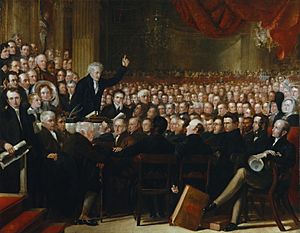
Several graduates of St John's College were very important in the movement to end the British Slave Trade. This effort led to the Act of 1807, which made the slave trade illegal. Key figures included Thomas Clarkson, William Wilberforce, Thomas Gisborne, and Thomas Babington.
In 2007, St John's College hosted events to remember the 200th anniversary of the 1807 Act. This included a public talk by President Ruth Simmons of Brown University, who is a descendant of American slaves.
See also
 In Spanish: Saint John's College (Cambridge) para niños
In Spanish: Saint John's College (Cambridge) para niños


